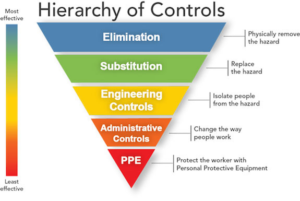Hazard Assessment
A Hazard Assessment involves identifying the potential dangers of our jobs, and how we are protected from them. Hazard Assessments are required by employers under Alberta’s OHS Code, Part 2.
Workers should be involved in a Hazard Assessment when we first start a job, or when the work changes. For some of us whose job tasks or locations change frequently, we may need more regular Hazard Assessments.
Types of Hazards
Some hazards are easier to identify than others. But many hazards are invisible to most of us, and we sometimes have to work harder to spot certain hazards. Using Hazard Categories when doing our Hazard Assessment can be useful:
Chemical: liquids, gases, solids, vapours, mists (flammable, combustible, caustic, carcinogenic, etc.)
Physical: affects body at a molecular level (energy source hazards such as radiation, noise, vibration, temperature, etc.)
Biological: microscopic organisms, infectious (bacteria, fungus, moulds, viruses, etc.)
Ergonomic: poor work design (posture, force, repetition, etc.)
Psychosocial: workplace stressors (bullying, harassment, threat of violence, shiftwork, boring work, lack of control, etc.)
Safety: thing, condition, procedure (faulty equipment, blocked exits, unguarded machinery, spills leading to slipping, etc.)
(source: Workers’ Health and Safety Centre, Ontario)
How to Protect Workers – Hazard Elimination and Control
As health and safety activists, we should always be thinking about how to best protect workers. A useful tool for this is called the Hierarchy of Elimination and Control. Getting rid of the hazard or making sure that it can never reach the worker is the most effective way of protecting people, rather than relying only on Personal Protective Equipment or training a worker to “be safe” (these kinds of solutions do nothing to deal with the actual hazard).

(source: NIOSH)
It is important that workers follow the health and safety rules of our workplace, such as wearing proper PPE, even if we think there may be a more effective way of controlling a hazard. Our HSC or H&S Rep can help make recommendations for better worker protection, and our Union (if we have one) can negotiate for better protection in our Collective Bargaining Agreement.